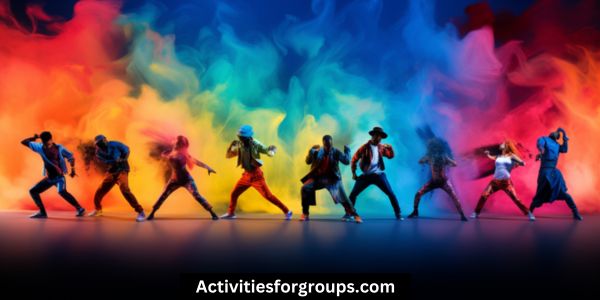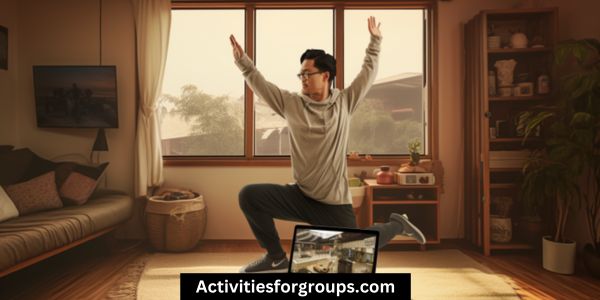Do you want to learn how to dance but don’t know where to start? Group dance classes could be the answer!
Not only do they provide you with the support and motivation of fellow learners, but they also offer physical, mental, and social benefits.

And with a variety of classes offered, you can choose the one that fits your lifestyle and learning goals.
So why not give group dance classes a go?
Social Benefits
You can socialize and make friends when you join group dance classes. Group dance classes offer a unique opportunity to meet people and form relationships. Students can learn collaborative learning skills and take part in team building activities with other dancers. The social environment of a group class allows for more casual interactions, allowing participants to connect and bond over shared interests.
In a group class, the instructor can also teach proper social etiquette, like greeting others during class and being respectful of each other. These types of experiences can help build self-confidence and empathy, and can even help prevent bullying. Additionally, group classes allow participants to be part of a community and to learn and grow together, creating a sense of camaraderie and support.
Group classes also provide the chance to have fun and experience the joy of dance with other people. It’s a great way to stay motivated and be part of a larger dance community. With group classes, students can gain feedback from the instructor and other dancers, which can help them improve their technique and performance.
Physical Benefits
By joining a group dance class, you can reap numerous physical benefits.
You can improve your coordination, as you’re required to move in sync with the other dancers.
You’ll also increase your stamina, as you’ll receive practice with longer routines and more difficult movements.
You’ll build strength, as you’ll have to lift your own bodyweight and support other dancers.
You’ll also burn more calories, as group classes tend to be more aerobic than solo dance sessions.
Plus, you can gain flexibility, as you’ll be asked to stretch more than usual.
Finally, you’ll gain better balance, as you’ll be learning to stay on your feet while dancing with others.
All of these physical benefits can be yours when you join a group dance class.
Mental Benefits

Joining a group dance class can provide many mental benefits to its participants. A supportive atmosphere is one of the key aspects of taking part in a group dance class.
With the help and encouragement of other participants, the individual is able to stay motivated and continue to progress in their class. This can lead to a sense of accomplishment as the individual sees their own progress as well as that of their peers.
| Benefit | Description | Impact |
|---|---|---|
| Supportive | A safe space to take part in the class with the help of other participants. | Increased motivation |
| Sense of Acc. | Seeing the progress of oneself as well as that of their peers. | Improved self-esteem |
| Social | Meeting and interacting with other participants in the class. | Strengthened bonds |
| Confidence | Learning new skills and being able to apply them in different contexts. | Improved self-image |
| Emotional | Feeling a sense of joy and satisfaction from dancing with other participants. | Heightened happiness |
Flexibility
How often can you adjust your individual dance classes to suit your needs? With group dance classes, you have much greater flexibility when it comes to your learning experience. Here are just four of the advantages of organizing group classes over individual sessions:
- Cooperative learning: Group classes allow for a more collaborative and social learning experience. Everyone has the opportunity to learn from each other and help each other improve.
- Mutual motivation: Being surrounded by others with similar goals can help keep everyone motivated. Knowing that you’re not alone on your journey to becoming a better dancer can be incredibly powerful.
- Customizable sessions: In a group setting, you can tailor the class to suit individual needs. For instance, if some students are more advanced than others, the instructor can provide different exercises for each group.
- Flexible scheduling: Group classes make it easier to schedule around everyone’s individual needs. If someone needs to miss a session, it won’t affect the rest of the group, and you can easily reschedule the class for a time that works for everyone.
Fun Factor

One of the biggest advantages of group dance classes is the ability to have fun while learning. With a group of friends and experienced instructors, the atmosphere is conducive to learning and enjoying the activity together. This enhanced morale increases the likelihood of learning and mastering the steps quickly. Group classes also help to improve teamwork, which is essential for executing complex dance moves.
In addition, group dance classes provide a great platform for socializing and making new friends. This helps to break the ice and create a friendly atmosphere, which in turn encourages people to learn and perform better. With more people in the class, everyone feels more energized and motivated to get the moves right.
Group classes also provide good opportunities for feedback from instructors and peers. This helps to identify mistakes and rectify them quickly. This allows dancers to quickly learn the steps and progress faster. And because everyone is learning and practicing together, it’s more likely that dancers will stay motivated.
Frequently Asked Questions
How Much Does It Cost for Group Dance Classes?
The cost of group dance classes will depend on the type of class and the number of people attending. Connecting with others and developing socializing skills are included in the cost, making it a great value.
How Many People Typically Attend Group Dance Classes?
How many people join group dance classes? It depends on the class size, but typically up to 10 people will socialize and build camaraderie together.
What Type of Dance Styles Are Available for Group Classes?
You can choose from a variety of dance styles for group classes! Socializing and teamwork are key components for a successful experience. Popular dances include salsa, hip-hop, ballet, ballroom, and jazz. Have fun and get moving!
Is There an Age Limit for Group Dance Classes?
Is there an age limit for group dance classes? It depends on the class, but generally most classes are open to all ages. Group classes allow for socializing and learning dynamics, making them ideal for all ages.
What Should I Wear to a Group Dance Class?
You should wear comfortable clothing that allows for movement and appropriate dance shoes. Remember to stay motivated and follow basic dance etiquette by respecting your fellow classmates and the instructor.
Conclusion
Group dance classes offer several benefits over individual sessions. This includes social, physical, and mental benefits. They also provide flexibility and an extra layer of fun. Whether you’re looking for a great workout or a chance to let loose and have some fun, group dance classes are a great way to do it.
So get out there and get grooving with your friends!




Leave a Reply